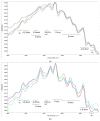Evaluation of Changes in Protein Quality of High-Pressure Treated Aqueous Aquafaba
- PMID: 33466395
- PMCID: PMC7795008
- DOI: 10.3390/molecules26010234
Evaluation of Changes in Protein Quality of High-Pressure Treated Aqueous Aquafaba
Abstract
Chickpea cooking water (CCW), known as aquafaba, has potential as a replacement for egg whites due to its emulsion and foaming properties which come from the proteins and starch that leach out from chickpeas into the cooking water. High pressure (HP) processing has the ability to modify the functional characteristics of proteins. It is hypothesized that HP processing could favorably affect the functional properties of CCW proteins by influencing their structure. The objective of this study to evaluate the effect of HP treatment on the associated secondary structure, emulsion properties and thermal characteristics of CCW proteins. A central composite rotatable design is used with pressure level (227-573 MPa) and treatment time (6-24 min) as HP variables, and concentration of freeze dried CCW aquafaba powder (11-29%) as product variable, and compared to untreated CCW powder. HP improves aquafaba emulsion properties compared to control sample. HP reduces protein aggregates by 33.3%, while β-sheets decreases by 4.2-87.6% in which both correlated to increasing protein digestibility. α-helices drops by 50%. It affects the intensity of some HP treated samples, but not the trend of bands in most of them. HP treatment decreases Td and enthalpy because of increasing the degree of denaturation.
Keywords: aquafaba; emulsification properties; high pressure processing; protein quantification by ftir; thermal properties.
Conflict of interest statement
Authors confirm that there is no conflict of interest in the work.
Figures








References
-
- de Almeida Costa G.E., Silva Queiroz-Monici K., Reis S.M.P.M., de Oliveira A.C. Chemical Composition, Dietary Fibre and Resistant Starch Contents of Raw and Cooked Pea, Common Bean, Chickpea and Lentil Legumes. Food Chem. 2006;94:327–330. doi: 10.1016/j.foodchem.2004.11.020. - DOI
-
- Xu Y., Obielodan M., Sismour E., Arnett A., Alzahrani S., Zhang B. Physicochemical, Functional, Thermal and Structural Properties of Isolated Kabuli Chickpea Proteins as Affected by Processing Approaches. Int. J. Food Sci. Technol. 2017;52:1147–1154. doi: 10.1111/ijfs.13400. - DOI
-
- Chávez-Murillo C.E., Veyna-Torres J.I., Cavazos-Tamez L.M., de la Rosa-Millán J., Serna-Saldívar S.O. Physicochemical Characteristics, ATR-FTIR Molecular Interactions and in Vitro Starch and Protein Digestion of Thermally-Treated Whole Pulse Flours. Food Res. Int. 2018;105:371–383. doi: 10.1016/j.foodres.2017.11.029. - DOI - PubMed
Publication types
MeSH terms
Substances
LinkOut - more resources
Full Text Sources
Other Literature Sources
Research Materials
Miscellaneous

